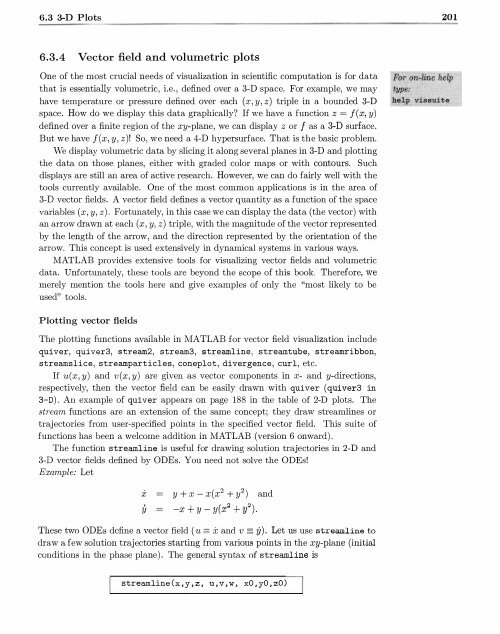Create successful ePaper yourself
Turn your PDF publications into a flip-book with our unique Google optimized e-Paper software.
6.3 3-D Plots<br />
201<br />
6.3.4 Vector field and volumetric plots<br />
One of the most crucial needs of visualization in scientific computation is for data<br />
that is essentially volumetric, i.e., defined over a 3-D space. For example, we may<br />
have temperature or pressure defined over each (x, y, z) triple in a bounded 3-D<br />
space. How do we display this data graphically? If we have a function z = f ( x, y)<br />
defined over a finite region of the xy-plane, we can display z or f as a 3-D surface.<br />
But we have f(x, y, z)! So, we need a 4-D hypersurface. That is the basic problem.<br />
We display volumetric data <strong>by</strong> slicing it along several planes in 3-D and plotting<br />
the data on those planes, either with graded color maps or with contours. Such<br />
displays are still an area of active research. However, we can do fairly well with the<br />
tools currently available. One of the most common applications is in the area of<br />
3-D vector fields. A vector field defines a vector quantity as a function of the space<br />
variables ( x, y, z) . Fortunately, in this case we can display the data (the vector) with<br />
an arrow drawn at each (x, y, z) triple, with the magnitude of the vector represented<br />
<strong>by</strong> the length of the arrow, and the direction represented <strong>by</strong> the orientation of the<br />
arrow. This concept is used extensively in dynamical systems in various ways.<br />
<strong>MATLAB</strong> provides extensive tools for visualizing vector fields and volumetric<br />
data. Unfortunately, these tools are beyond the scope of this book_ Therefore, we<br />
merely mention the tools here and give examples of only the "most likely to be<br />
used" tools.<br />
Plotting vector fields<br />
The plotting functions available in <strong>MATLAB</strong> for vector field visualization include<br />
quiver, quiver3, stream2, stream3, streamline, streamtube, streamribbon,<br />
streamslice, streamparticles, coneplot, divergence, curl, etc.<br />
If u(x, y) and v(x, y) are given as vector components in x- and y-directions,<br />
respectively, then the vector field can be easily drawn with quiver (qui ver3 in<br />
3-D). An example of quiver appears on page 188 in the table of 2-D plots. The<br />
stream functions are an extension of the same concept; they draw streamlines or<br />
trajectories from user-specified points in the specified vector field. This suite of<br />
functions has been a welcome addition in <strong>MATLAB</strong> (version 6 onward).<br />
The function streamline is useful for drawing solution trajectories in 2-D and<br />
3-D vector fields defined <strong>by</strong> ODEs. You need not solve the ODEs!<br />
Example: Let<br />
x y + x - x(x 2 + y 2 ) and<br />
Y<br />
-x + Y - y(x2 + y2).<br />
These two ODEs define a vector field (u = x and v = y). Let u::; use streamline to<br />
draw a few solution trajectories starting from various points in the xy-plane (initial<br />
conditions in the phase plane). The general syntax of streamline is<br />
streamline (x,y,z, u,v,w, xO ,yO,zO)



